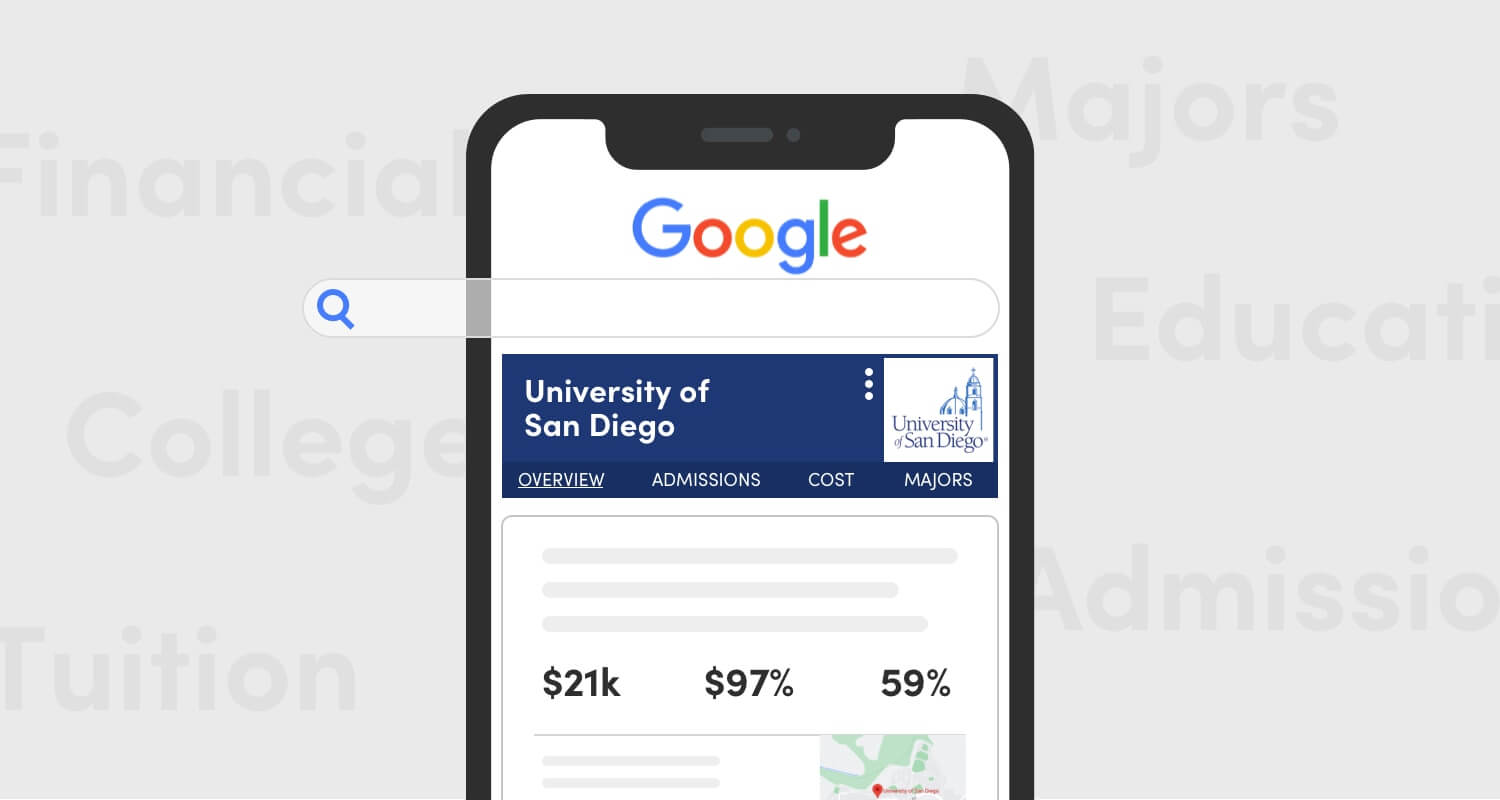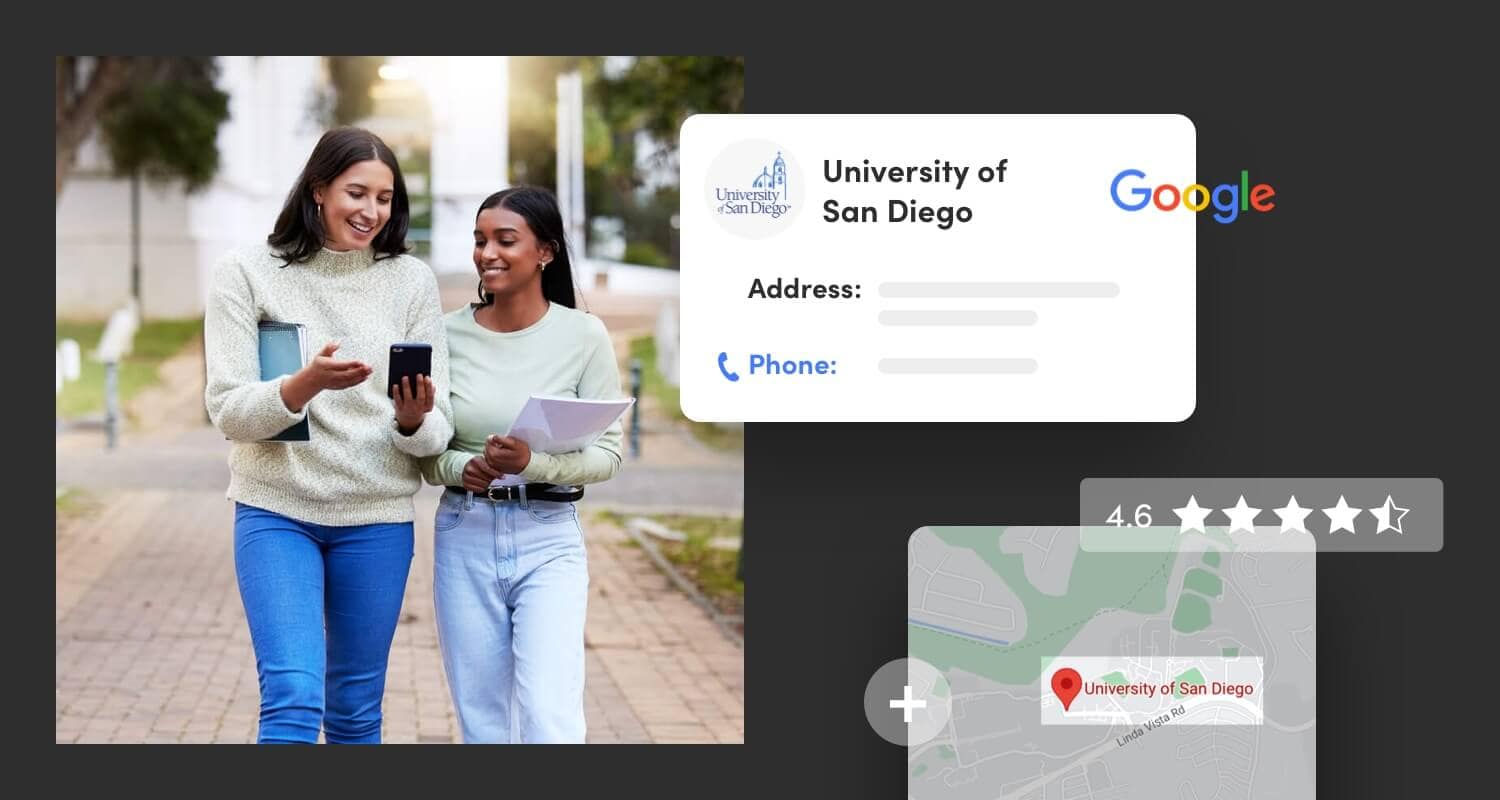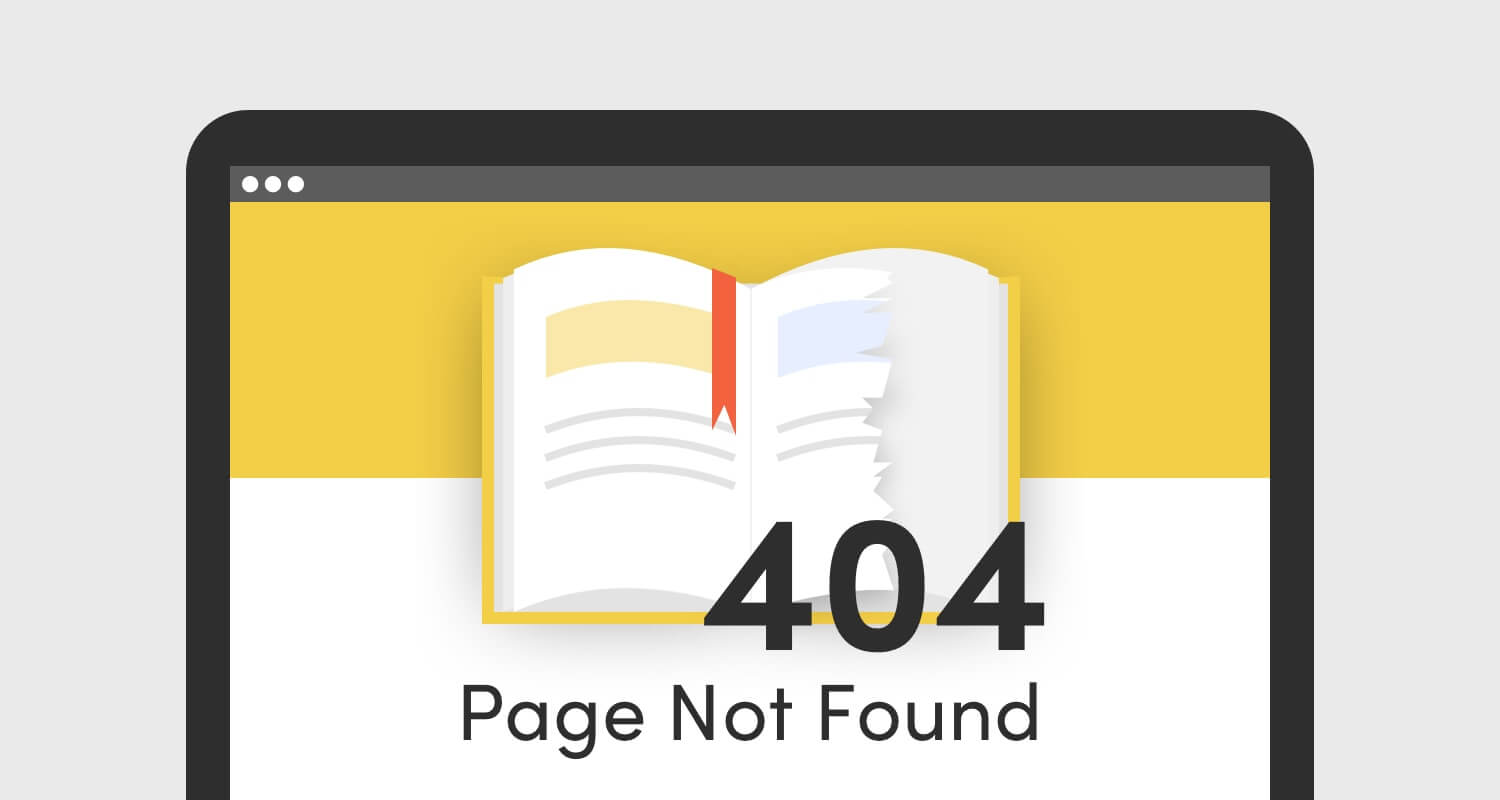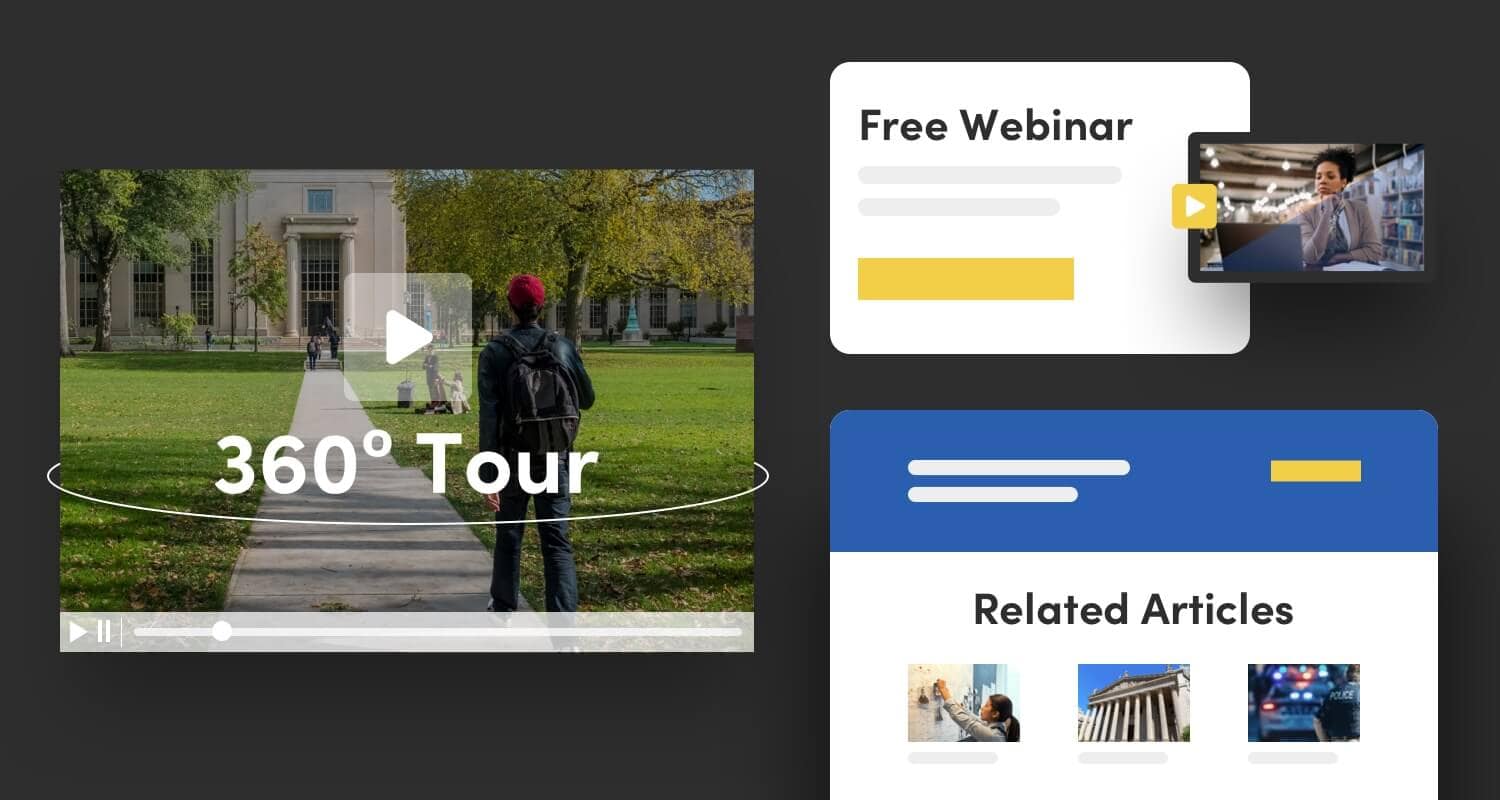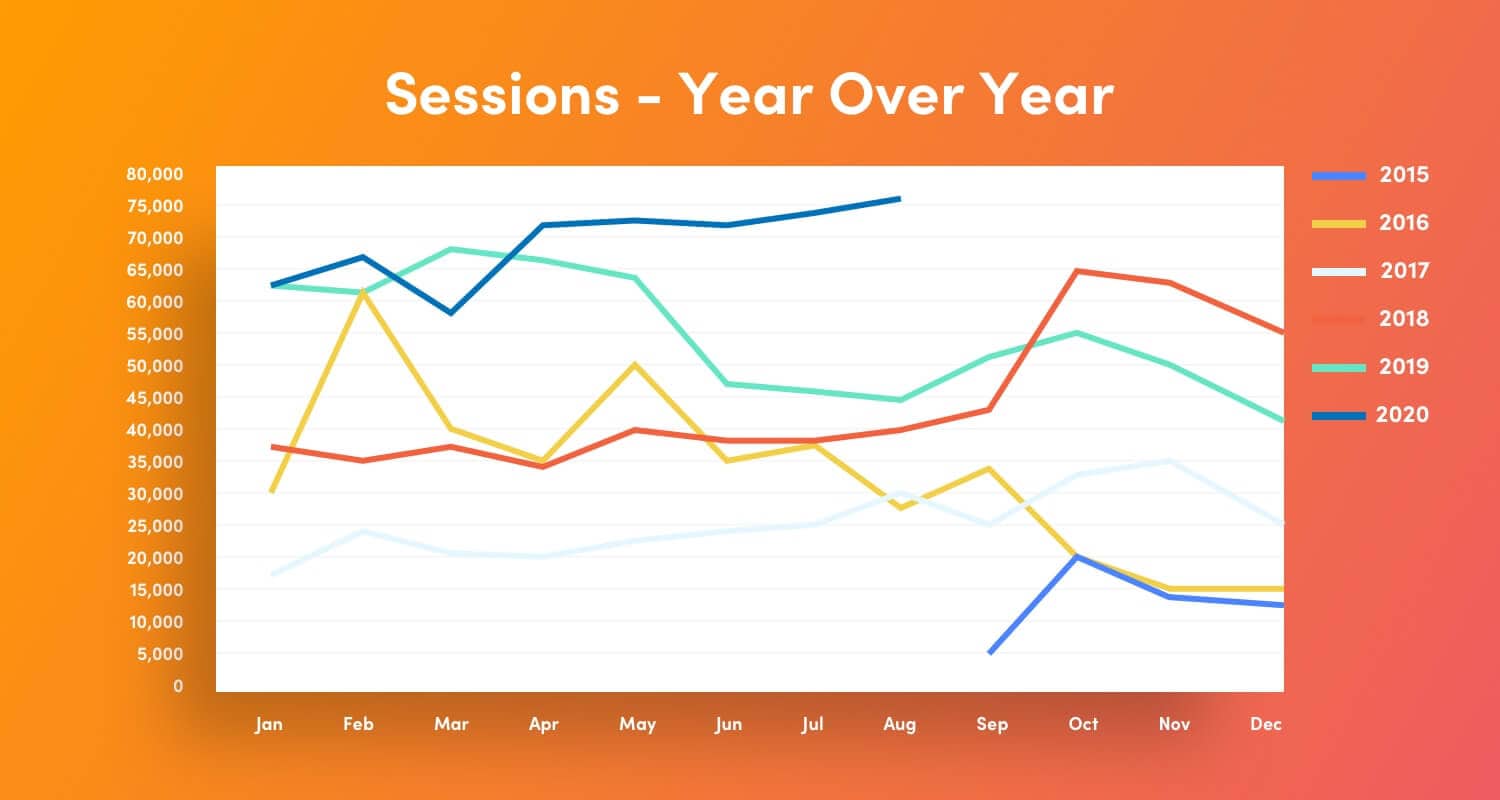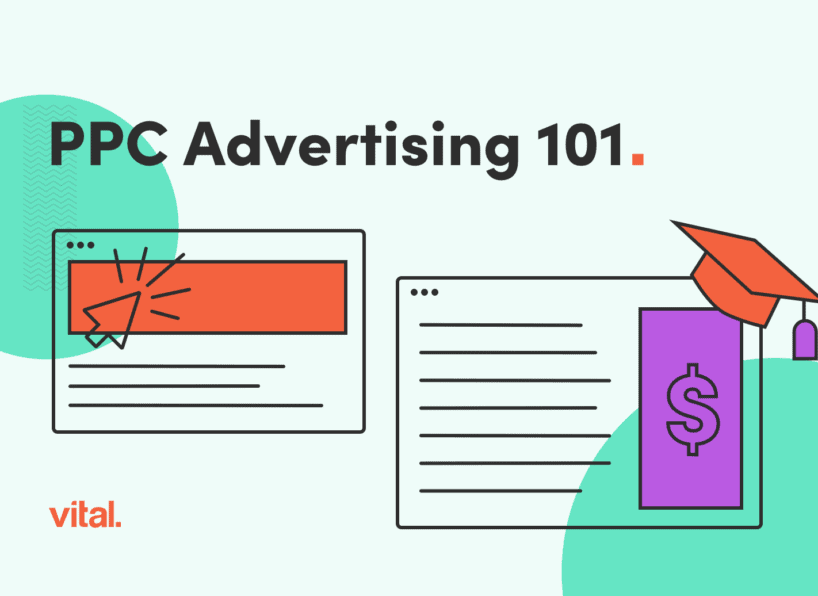How do today’s students find the colleges and degree programs they want to attend? They Google it, of course. Online search is the top method for starting the college decision journey, and thanks to Google’s most recent college search features, it’s easier than ever for prospective students to compare colleges at a glance.
So, how does this impact your college or university’s digital marketing strategy? With increased functionality in college search, if your website or webpage’s position is low, prospective students may miss the opportunity to learn more about your programs or campus life. If you want to drive prospective students to explore beyond Google’s quick-look comparison, you need to stay on top of the latest best practices for higher education SEO.
Here’s how.
What Is SEO?
Search engine optimization (SEO) is the process of increasing your website or webpage’s accessibility to maximize its traffic and rank higher on search engine results pages (SERPs). And with over 90% of the worldwide search engine market share, Google is the place to begin.
You may be wondering what your placement on Google has to do with enrollment. The answer is that it’s all about driving prospective students to your website. The number one position on Google gets an average click-through rate of 27.6%, compared to 2.4% for number ten. And less than 1% of internet searchers click onto the second page of a Google search. The higher you are on page one, the better visibility you have. More traffic leads to more conversions, and ultimately, better enrollment numbers.
Although there are hundreds of different factors that influence ranking, today’s post covers the fundamentals that will have the greatest impact on your college or university’s overall strategy. So, let’s take a look at how universities can leverage SEO to get in front of their students.
Identify Your Ideal Student
Your college or university is unique, and so is your student population. To maximize the effectiveness of your SEO strategy, you need to optimize your pages for keywords and phrases that are relevant to the students who are most likely to apply to, and ultimately enroll, in your school. A large public university with low in-state tuition and a strong vocational focus will attract different students than a small, private liberal arts college. If you’re not tailoring your keywords to your audience, you might get a lot of traffic, but ultimately that traffic won’t boost your enrollment numbers nearly as much as it could.
Start by creating student personas based on your current and ideal students. Look for trends in demographics, interests, and decision drivers. There’s no need to get too granular; these personas are meant to be representative of archetypes rather than individuals. Examples of student persona archetypes include:
- Budget-conscious high school students
- Status-driven high-achievers
- Adult learners
- Etc.
If your university is particularly strong in particular academic areas or programs, your personas should include students who are specifically interested in those programs. Creating archetypes allows you to dig deeper into your ideal students’ motivations, so you can target searches based on intent.
What is searcher intent? This is a way of identifying how searchers will act based on what they’re searching for. For example, someone searching for “best jobs for English majors” may be in the market for a college with a strong English department.
Once you have your target student personas, you can begin to create keyword-driven content tailored to those personas. Think in terms of content clusters rather than one-offs. A mini-library of blog posts on topics your prospective students are interested in will keep them engaged with your school and help move them through their decision-making journey.
Protip: Maximize your higher ed SEO impact with video and social media.
When planning your content calendar, make sure you build higher ed social media and video content into the mix. Today’s college searchers are on YouTube and TikTok, so meet them where they live.
Student personas will help you identify keywords and phrases to target with your content — but how exactly do you make sure that content actually ranks high on the SERP for your keywords? To begin answering that question, you’ll need to audit your college website’s SEO and compare it to the competitors that are currently ranking for the keywords you’re after.
Keyword Research for Higher Ed SEO
Where do you come up with keywords to drive your SEO content? By thinking like your target audience. Consider words and topics that prospective students would search; these become your “keywords.” Keep a running list in a spreadsheet. Enlist the help of admissions counselors and other admins that tend to speak with students the most. You may even have helpful data from previous Q&A sessions.
After you’ve compiled the list, you’ll need to enlist the help of a keyword tool, like Google’s Keyword Planner, to determine each keyword’s popularity and help measure the competition to organically rank for each keyword.
But thorough keyword research requires much more. When you dive deeper (and use even more advanced tools), you can uncover related long-tail phrases (inquiries over one or two words). For example, if students are searching for the short-tail phrase “criminology programs,” are there others searching for “criminology programs with internships?”
Each of these longer queries provide opportunities to strategically develop your content and showcase your program’s specific value adds. By unraveling your audience’s search requests, you can create premium content, blog posts, and virtual events to answer their most burning questions. Then, you can begin driving traffic to your website.
Protip: Include a healthy mix of short-tail and long-tail keywords.
What’s the difference between short-tail and long-tail keywords? Short-tail keywords are more general and contain one or two keywords. They generally have higher search volumes but lead to lower conversion rates because searcher intent is harder to determine. Long-tail keywords are very specific queries, often phrased as a question, containing three or more words. They’ll generate less volume but perform well over time, because content that ranks for long-tail keywords is likely to be very relevant to searcher intent.
You’ll also want to consider both branded and non-branded keywords. Branded keywords include your college or university name, so you get searchers who are looking for you specifically. It’s important to rank organically for your branded search terms — but it may be even more important to focus on non-branded terms, since that’s the best way to reach a new audience of potential students.
Internal SEO and Competitor Audits
SEO audits are integral to help identify elements of your website that are preventing it from being accurately crawled or indexed, and therefore harming your ranking. Once these red flags are identified, it’s time to fix them.
How do you conduct an SEO audit?
Since there are so many factors that impact SEO, it’s essential to take a holistic view if you want to create the most thorough and effective strategy.
In addition to some technical barriers, someone conducting an audit without a strong background in SEO could overlook important structural nuances. For example, a piece of content may be written very well, but the blog post’s technical structure could be harming your site due to slow page load time or pagination that’s unable to be crawled by search engines.
Here at Vital, we break our audit into four different sections; then, we take the time to comb through each ranking factor to identify technical issues. We’ll divide up each SEO consideration and place them in a priority hierarchy. For example, our “priority one section” includes the biggest problems that will also have the biggest impact once they’re fixed.
At the end of the audit, we may end up with 30 or more different considerations in a logical order. Then, we run through that list and fix each issue.
What about a competitor audit?
Your internal audit is only half the battle, which means audits of your competitors are the other half.
When we conduct competitor research, we analyze three things:
- Their SEO
- Their paid advertising strategy
- Their conversion and messaging strategy
Within those digital marketing tactics, these are the important questions to ask:
- Which competitors can we learn from?
- What are our competitors doing really well that’s causing them to outrank us?
- What are our competitors’ top-ranking pages?
- What other sites are linking to them? (This is a key factor in Google search rankings.)
- What keywords they’re bidding on for their paid search budget?
- What ads are they running?
- What are their conversion offerings? Are they utilizing premium content downloads? Virtual campus tours or events? Chatbots?
All of that insight is informative; it lets us know which areas we may need to strengthen. Then, we can benchmark the internal audit against each competitor with tangible data showing how many keywords they have, what kind of content they’re creating, and where we stack up by comparison.
Best Practices for Higher Education Site Content (10 Tips)
As you begin comparing yourself to your competition, you may notice a pattern: Online universities are really hitting the mark with SEO. This primarily has to do with page structure, specifically subdomains vs. subdirectories. Since this is one of the most important factors for ranking, we’ve already dedicated an entire post to exploring the differences and discussing their impact on your website.
Now, what if you can’t fix your website’s structure? That’s OK. As we’ve already mentioned, there’s no shortage of SEO considerations on which to focus your attention. It would be overwhelming to cover everything. Since we’ve already talked about auditing your site, let’s take a step back and cover ten SEO best practices:
- Take advantage of local search, college directory listings, and review sites
- Let your keyword and competitor research define your content strategy and content calendar
- Remedy duplicate content
- Improve your site’s Expertise, Authoritativeness, and Trustworthiness (E-A-T)
- Build unique pages for the most searched-for content on your university website
- Fix broken links
- Optimize your website for speed and performance
- Use videos and premium content to improve CRO and time on page
- Mobile first/responsive web design
- Get your off-page details right
1. Take advantage of local search, college directory listings, and review sites
For an online degree program targeting people across the country, local search might not be very relevant. But for a college attracting an on-campus audience, it’s integral.
There are a number of factors that help your local SEO (yes, there’s a common theme here), including garnering links from local businesses; utilizing a consistent NAP (name, address, and phone number) across your website/external listings; and utilizing Schema.org and Google My Business to properly signal your website’s relevance to search engines. We’ll dig a little deeper into those two tools below.
Review sites and directories can be extremely helpful, but it all depends on their performance. Do they rank for your target keywords? If so, how many and how much traffic are they accruing? That will tell you if it’s worth having a review or directory link on those sites.
Ultimately, you want to ask whether people are actually seeing them. In the higher education space, there are plenty of sites that are solely reviewing the best criminal justice degrees. This kind of niche will help tremendously. If someone browses your criminology program for a while then stumbles upon one of these review sites, you’ll want to appear there to help validate your program in that prospective student’s eyes.
2. Let your keyword and competitor research define your content strategy and content calendar
The competitor review and initial keyword research essentially build your content calendar. All of this data is hugely influential when you have the knowledge to use it most effectively.
For example, if you’ve identified a target group of keywords, but don’t rank for them and don’t have a page that could, it’s time to create a page with new content that will address some of those queries.
After you’ve nailed your keywords, you can scour Google Analytics and observe which pages are converting well and which ones aren’t. What about the existing pages that are driving a lot of traffic but not converting? That behavior tells you that the topic is intriguing, but the offer clearly isn’t working. So, let’s use the data we’ve gathered to optimize that existing content and create a new offer that resonates better. Always prioritize impact.
3. Remedy duplicate content
Duplicate content does the opposite of creating impact. Google’s Panda algorithm update places authority on original content and penalizes websites that appear to be repeating similar content over several pages in an effort to manipulate the search engine. When the search engine discovers more than one URL with the same content, it’s unclear which one to rank higher, so both pages suffer.
A lot of academic programs create a “criminal justice degree page,” and then subsequent pages for each course included in the degree. This could quickly add up to 30 or so different pages of individual courses featuring very similar content since they’re all linked to the same major. This structure could harm your appearance on the SERP.
Academic content optimization would consolidate those course offerings onto the original program page with a table of content that allows prospective students to jump to each topic on one page. Ultimately, you end up with a much less jarring user experience and an SEO-friendly page that has an opportunity to rank much higher.
4. Improve your site’s Expertise, Authoritativeness, and Trustworthiness (E-A-T)
Now that we’ve discussed some strategies for optimizing your content, let’s start talking about domain authority. Backlinko’s Brian Dean says, “Domain Authority used to be all about links. Not anymore. Today, Google also evaluates your site based on Expertise, Authoritativeness, and Trustworthiness. Also known as E-A-T.”
E-A-T has been important for years, but that’s even more true today. Google’s How Search Works page on ranking results says that “quality of content” is a direct ranking factor — and E-A-T is the main way Google determines quality.
So, how do you improve your college’s E-A-T score? Well, backlinks do factor in. But today the authority of the site that links to your content is more important than ever. In addition, you don’t even need a link to boost your E-A-T — just being mentioned by a highly authoritative source (say, The New York Times) can do the trick.
This is good news for colleges and university marketers looking to improve their SEO through E-A-T, because you have access to academic subject-matter experts who can author content that’s both relevant to your ideal audience and highly authoritative and trustworthy.
5. Build unique pages for the most searched-for content on your university website
Using keyword research as a guide, you can identify opportunities to create new pages on your college website. Typically this means you should have unique pages for your school’s:
- Individual degree programs
- Faculty and staff members
- Financial aid offerings
- And anything else your prospective students want to find.
When building pages, remember to avoid duplicating content word-for-word, even if some pages cover similar material.
6. Fix broken links
Broken links are pretty straightforward. From a technical standpoint, this means that you have a URL that was changed but not redirected, so the user only sees a 404-error page. That’s an embarrassingly bad user experience. When Google crawls your site and continuously lands on dead ends, your page authority decreases and your ranking drops. Thankfully, these are an easy fix. You should catch any 404s in your SEO audit and simply redirect the traffic.
Although they’re bad on your site, broken links on other sites present a unique opportunity: broken link building. This strategy involves using a tool, like SEMrush, to find content that was ranking but no longer exists. Maybe you have some content that would fit that void perfectly. Then, you can reach out to the website host and mention that their link is directing to a 404 page, offering your content in its place. You’re improving their site and they’re simultaneously helping you build backlinks. But remember to make sure your backlinks are from reputable sources; otherwise, they’ll actually hurt your SEO.
7. Designing and testing optimal UX for college websites
As of 2021, website performance, including page speed, is a direct ranking factor for SEO. It’s also a factor in your conversion rate, because users are likely to abandon your site if it takes more than a few seconds to load. During your SEO audit, you should certainly be assessing your website speed using a tool, like WebpageTest, that essentially “grades” your website.
This tool reports important information, like: What’s your time to first byte (TTFB), the time it takes a user to start receiving content? Is static content being cached? Does your website use a content delivery network (CDN) to help minimize delays? If you’re running a lot of scripts, they all need to load before the content appears; these could be optimized to load in a single layer. Then you can understand why it’s loading so slowly and where to focus your attention.
Many times, it’s as simple as image compression. Since university and college websites are typically image heavy, simply taking note of image size could make a huge difference for your website speed.
You also want to make sure your site is built with mobile-first design. This is so important, it gets its own section.
8. Use videos and premium content to improve CRO and time on page
Although you want to make sure you don’t have giant files on your site, premium content will help improve time on page and conversion rate optimization (CRO). In fact, people spend an average of 1.4x more time on pages with video than those without.
The longer they spend on the page, the more time they have to increase their confidence in your institution and notice additional CTAs. Now that you’ve guided them a little further in their buyer’s journey, they might be ready for the next step. Most websites are built to only address the bottom of the funnel and only address the sale. “Enroll today.” Well, why should they?
Only a small percentage of your traffic may be ready to “enroll today,” so you could be missing a whole audience of prospective students. Instead of alienating this group, create a strategy that guides them toward enrollment.
Let’s talk about a prospective student who stumbles upon your hypothetical criminal justice degree page. They watch a video highlighting the program’s internship opportunities and a few quick testimonials from alumni who secured jobs after graduation, one of whom chose to pursue a law degree at your university and went on to become a judge. You’ve probably captured your audience’s attention, so what’s next?
Give them strategic and informative offers. Perhaps an article titled, “How to Determine if a Criminal Justice Degree is Right for You?” At the end of that article, you could include a link to a virtual event with the now-judge-alumni discussing their journey through your program and the ease of the track to law school, not to mention the connections they developed, which ultimately helped them secure their dream job.
Creating this type of experience is more likely to convince your prospective student to reach out for enrollment information, or even to apply. But without carefully guiding them through their buyer’s journey, you could have lost them at “enroll today.”
9. Mobile first/responsive web design
How else will you lose prospective students? When your site takes too much time and effort to navigate.
As of 2019, Google switched to mobile-first indexing, meaning it primarily crawls and indexes pages via smartphone. Not only will a terrible mobile user experience harm your ranking, it could turn students off from your institution entirely. Your audience has very small tolerance for slow load times on mobile since it takes up the entire screen. Don’t lose them over something that you could fix.
10. Get your off-page details right
SEO is a combination of content optimization (keywords) and technical optimization (site performance), with a little bit of off-page optimization thrown in. Don’t neglect the following off-page elements in building search-optimized pages:
- Title tag: It should contain your main keyword and should NOT be identical to your H1.
- URL: A search-friendly URL is short and contains your main keywords, rather than just duplicating the entire title of a page.
- Meta-description: This isn’t actually a huge SEO factor, but a well-written meta-description will encourage users to click on your link.
- Alt text: Include alt text for all images.
Now that we’ve given you ten different considerations to jump start your SEO strategy, let’s talk about seven tools that will help get you there. (We’ve already mentioned a few of them.)
Popular SEO Tools for University Websites
There’s no shortage of tools promising to help improve your website’s SEO. So which should you use? We took a look at 12 of the most popular SEO tools for higher ed websites:
1. Google Analytics
This is an excellent website analytics service to track and report your website traffic. By using Google Analytics, you can identify user behavior, such as pages generating high traffic and low conversions. Then, you can take a look at the page and see if there’s a better call to action that you could implement on the page to help CRO.
2. Google Search Console
Google Search Console gives you tools and reports to improve your search performance on Google. You can measure your site’s search traffic and performance, identify and fix issues that might be hurting your SEO, and generally make sure your site is optimized for Google.
3. SEMRush
We’ve covered keywords, audits, and backlinks. What does SEMrush do? All that and more. They leverage their immense database of over 808 million domains and 20 billion keywords to complete your own keyword research, track your competitor’s strategy, run your SEO audit, and identify opportunities for you to gain better search traffic.
4. Yoast
Yoast has a bunch of SEO plugins for different applications. We like them because their Yoast SEO for WordPress plugin is one of the best tools for optimizing a WordPress website. They also have plugins for video, local SEO, Google News, WooCommerce, and Shopify.
5. Screaming Frog
Screaming Frog has an “SEO Spider,” which crawls your website to audit it for common SEO issues. It’s a great tool for auditing and fixing your college website’s SEO, and for conducting SEO audits on your competitors.
6. Siteimprove
Siteimprove has three products aimed at improving your website’s accessibility, content experience, and marketing performance. We like it most for its accessibility testing. If you’re not sure whether your higher ed website is compliant with the latest accessibility standards, Siteimprove is a must.
7. DeepCrawl / Lumar
Formerly known as DeepCrawl, Lumar calls itself the fastest crawler on the market. It’s a bit more expensive than Screaming Frog, and it’s cloud-based whereas Screaming Frog is a download, but the functionality is similar between the two. Both work well for uncovering and fixing SEO issues on your website.
8. Ahrefs
A competitor of SEMRush, Ahrefs gives you tools to audit and optimize your site’s SEO, analyze your competition, explore keywords, dissect top-ranking competitor content, and track your progress on your way up the SERP. It’s nice and user-friendly despite the techie-sounding name, but we tend to choose SEMRush because it also gives you great PPC tools.
9. Moz
Moz is another “all-in-one” SEO tool, with features supporting site audits, rank tracking, backlink analysis, and keyword research. Generally speaking, we’ve found SEMRush to have slightly more useful reports and better ease of use.
10. Google Keyword Planner
Google’s Keyword Planner is intended for planning PPC campaigns, but it’s also super useful for keyword planning for SEO purposes.
11. AnswerThePublic
AnswerThePublic is a nifty “search listening” tool for coming up with long-tail keywords based on autocomplete trends for a single keyword or short phrase. Type in “Best Colleges,” and it will give you a list of 60 related questions people search for, 56 prepositions (i.e. “best colleges near the beach”), 37 comparisons (ie. “Best colleges or universities for veterinarians”), all presented both visually and as a downloadable CSV.
12. Keywords Everywhere
Keywords Everywhere is a browser extension for Chrome or Firefox. This tool helps uncover long-tail phrases and includes the search volume, cost per click (CPC), and related competition. Having deep keyword insight really drives an effective content strategy.
How SEO Impacts Your Higher Ed Marketing Strategy
SEO has the potential to increase enrollment. Everything we’ve talked about — ranking on Google, mobile-first indexing, and broken links — probably doesn’t mean a lot to you, but we bet enrollment does. If you outsource your SEO strategy to the right partner, then they won’t just talk about your rankings — they’ll talk about your goals.
You’re interested in getting a brand-new academic program off the ground? They’ll conduct the keyword research to see how students are searching and how you can position yourself at the top of the results page. How many enrollments do you want? They’ll build a strategy to maximize your numbers.
The value of SEO isn’t just in boosting your university’s website rank for your target keywords. The real value is guiding the next generation of students through your doors, students who may not have found you, students who can have an incredible impact on the world with the help of your university. Today, that’s more important than ever.
So, let’s introduce some new students to your school. If you’re interested in learning more about how Vital can help, please don’t hesitate to reach out. Talk to us about your enrollment goals, and we’ll bring the tactics.
Contact Us Today to Get Started >>
If this post piqued your curiosity and you’re interested in learning more, consider downloading our eBook, Top 10 Digital Marketing Strategies to Boost Enrollment for Higher Education to learn how SEO can work as part of a comprehensive digital marketing strategy.

